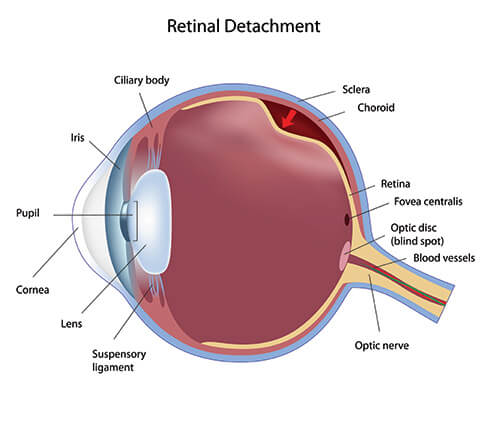What is a Retinal Detachment?
The retina is a layer of light-sensitive tissue located in the back wall of the eye. This layer of tissue is essential for clear and crisp vision.
When a retinal detachment occurs, this tissue pulls away from the back of the eye. This can cause various symptoms, including severe vision loss.
As your eyes and body age, many changes occur. One change that happens specifically in the eye is that the gel that fills the majority of your eye begins to shrink.
This gel is called the vitreous gel. When the vitreous gel shrinks, it can tug away or separate from the retina.
This is called a posterior vitreous detachment or PVD. Sometimes, a PVD can pull on the retina and allow fluid to accumulate behind the retina and in front of the back wall of the eye. In the worst-case scenario, the retina can completely detach from the back wall in various locations. A retinal detachment often causes immediate vision symptoms and requires prompt treatment to preserve vision.
What is a Retinal Tear?
A retinal tear is when a hole or tear is created in a portion of the retina. A retinal tear can lead to a more serious retinal detachment.
Similar to a retinal detachment, retinal tears often occur due to the shrinkage of the vitreous gel. Depending on the location of the retinal tear, you may experience blurry vision.
What Are the Symptoms of Retinal Detachment and Retinal Tears?
A retinal detachment and retinal tears may have similar symptoms. Although symptoms may vary from person to person, there are a few common symptoms:
- Flashing lights
- New floaters
- Changes in peripheral vision or seeing what appears to be a curtain or shade coming across your vision
If you experience any of these symptoms, visit your eye doctor right away. If your symptoms are a result of a retinal tear or detachment, your eye doctor may need to begin treatment immediately.

Retinal Detachment Treatment in Livingston
Not all retinal tears require treatment. If your retinal tear does not require immediate treatment, your eye doctor will likely monitor your eyes to ensure that the tear is not worsening.
In some cases, it may be important to treat the retinal tear to prevent a possible future retinal detachment. To do this, the eye doctor at Jackson Eye Care uses laser therapy to treat retinal tears.
During laser therapy, your eye doctor uses a freezing probe to help destroy damaged retinal cells. In addition, this therapy aims to seal any holes or tears through scar tissue formation.
Sealing these holes or tears can help prevent fluid from accumulating behind the retina. This process will also help prevent retinal detachments from happening in the future.
How Do Eye Doctors Treat Retinal Detachment?
If your retinal detachment requires treatment, eye doctors have many options at hand to remediate this condition. Your eye doctor at Jackson Eye Care may perform laser procedures such as photocoagulation or other surgical procedures like the scleral buckle, and vitrectomy to treat a retinal detachment.
Both photocoagulation and laser therapy procedures aim to create scar tissue to help the retina reattach to the eye wall, similar to using laser therapy to treat retinal tears. During the scleral buckle procedure, your eye doctor will place a silicone band around the eye.
This band will slightly alter the shape of your eye to help the retina re-adhere to the eye’s surface. In some cases, eye doctors perform a vitrectomy to remove all of the vitreous gel inside the eye.
Do you want to learn more about how eye doctors treat retinal detachments? Schedule an appointment at Jackson Eye Care in Livingston, NJ, today!
